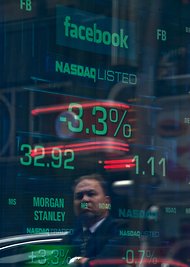But the company has still been taking pains to prove that it can make more money from its base of more than a billion users, especially from those using Facebook on mobile devices.
On Wednesday, the company reported earnings that suggested that its mobile efforts were bearing fruit. It said it had first-quarter revenue of $1.46 billion, exceeding the $1.44 billion estimate of financial analysts surveyed by Bloomberg News. The company had $219 million in net income.
The company has recently focused its efforts on increasing advertising revenue, especially on its mobile application, rolling out more than a half dozen new products in the last year. They include ad formats intended to help developers of applications find new customers, to promote messages in the mobile News Feed and more refined advertising tailored to consumers’ online and offline behavior.
About 30 percent of its total advertising revenue came from mobile devices, a significant increase from the last quarter, when mobile revenue accounted for 23 percent of the total. Facebook had not begun showing ads on its mobile application in the same quarter a year ago.
The company’s shares fell about 1 percent, closing the day at $27.43, before the earnings were reported. In early after-hours trading, shares were up 44 cents, or 1.6 percent, to 27.84.
“Over all, they’re on track,” said Aaron Kessler, an analyst with Raymond James. “They’re still rolling out new products for advertisers. They’re definitely more focused on creating shareholder value and driving revenue growth.”
A majority of Facebook users in United States log in using their mobile devices and according to a report by the market research firm comScore. Americans spent 23 percent of their time using Facebook’s mobile apps last year, an astonishing number considering all the apps on the market. Mark Zuckerberg, Facebook’s co-founder and chief executive, has said that the company can eventually make more money on every minute spent on the Facebook mobile app than on the desktop computer.
To that end, the company in early April introduced a package of mobile software for Android phones called Facebook Home, which is meant to nudge Facebook users to return to their mobile News Feeds even more frequently than they do now.
The new suite of applications effectively turns the News Feed into the screen saver of a smartphone, updating it constantly with Facebook posts and messages. It appears to be only a matter of time until the company introduces ads there.
Last May, Facebook held a widely publicized initial public offering, at a price of $38 a share. Its fairy tale rise took a sharp dive almost immediately, resulting in lawsuits and angry recriminations. Its shares slumped to half the opening price at one point last fall and have inched up cautiously since then.
On Wednesday, Facebook filed a motion asking a federal judge to dismiss a lawsuit that accused the company of misleading investors about its financial strategy before the public offering, Reuters reported. The company said in court papers that it was not legally obligated to disclose publicly how mobile adoption would affect its financial performance in the future.
Wall Street analysts have closely watched for signs of Facebook fatigue among users. In the first quarter, they point out, fewer monthly users returned to Facebook on their desktop computers in the United States and Europe, according to comScore figures.
Analysts worried whether it signaled that users in more mature and lucrative markets were getting bored with Facebook. But they noted all the same that the figures applied only to desktop users and revealed little about mobile users of Facebook.
Facebook is clearly concerned about keeping users glued to the site. Its overhaul of the News Feed, announced in March, was intended to accomplish that, with bigger pictures and links, including those for advertisements. Wall Street reacted enthusiastically to the redesign, predicting that it would deepen user engagement and offer advertisers a fresh, more interesting canvas.
Aaron Kessler, an analyst with Raymond James, cited a consumer survey in early April that showed mixed results: 32 percent of respondents said that they were using Facebook more than they did a year ago, but an identical share said their use had declined.
The company’s biggest move in advertising was allowing marketers to aim advertisements at Facebook users based on their online and offline habits. This year, the company has announced partnerships with data companies that collect detailed information about consumer behavior, including what they buy at brick-and-mortar stores. That data is being used to tailor advertisements on Facebook.
Nate Elliott, an analyst at Forrester Research, described those efforts as promising, but limited. Facebook’s trove of data about its users, he said, could be tapped to show used tailored advertisements on sites across the Web. “They’ve done nothing to suggest they see the bigger opportunity,” Mr. Elliot said.
Article source: http://www.nytimes.com/2013/05/02/technology/mobile-efforts-help-propel-facebook-earnings.html?partner=rss&emc=rss
